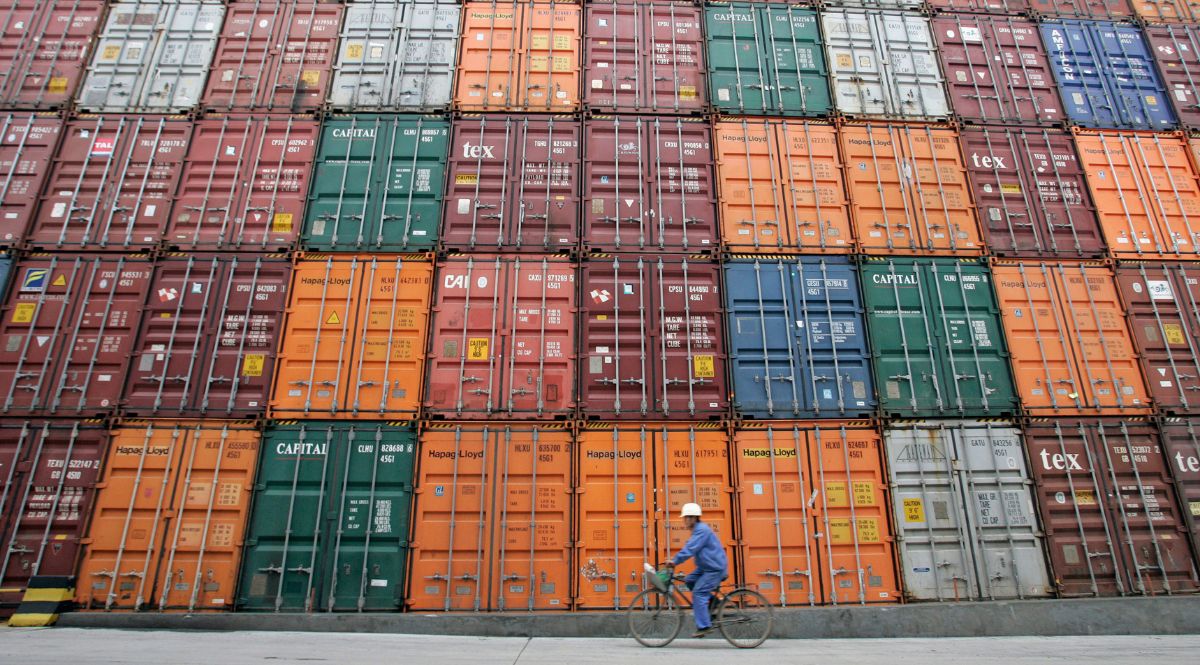Trump's Trade Policy Likely to Put Pressure on EU, Other U.S. Partners
Trade issues will be one of the most important areas of activity for the incoming U.S. administration. It will likely use aggressive negotiating methods to obtain economic and political concessions. Potential changes in U.S. policy, including increased tariffs, will have implications for global trade and could affect all U.S. partners. From the EU’s perspective, it is necessary to prepare for pressure from the U.S. side and seek opportunities for agreement so that an economic dispute does not undermine the Union’s strategic security cooperation with the U.S.
.png) Brian Snyder / Reuters / Forum
Brian Snyder / Reuters / Forum
Conditions
The United States has long been running structural foreign trade deficits, which worsened in the 1990s and especially after 2001 when China joined the WTO. According to the U.S. administration, in 2023, trade deficits in goods and services occurred with all major partners: China ($252.1 billion), Mexico ($162.1 billion), the EU ($125.1 billion), Vietnam ($102.9 billion), Japan ($66.1 billion), South Korea ($40.8 billion), and Canada ($40.6 billion). There are significant differences in relations with EU countries, with the U.S. running a deficit primarily with Germany ($87 billion), Italy ($47.1 billion), and France ($17.4 billion). With some countries (e.g., Spain and Croatia) it records small surpluses. In relations with the Netherlands ($62.5 billion) and Belgium ($16.3 billion), the sums are significant, which is mainly due to the registration of EU imports at Dutch and Belgian ports. According to Statistics Poland, in 2023 Poland had a goods trade deficit with the U.S. (calculated by country of origin; about $4.1 billion) and a surplus in services trade (about $6 billion).
The U.S. takes in surplus production from partners, who often invest the money they earn in the U.S. market, such as in treasury bonds, stocks, and real estate. Among other things, this allows them to keep the exchange rate of their currencies low, which would rise due to increased demand if the surpluses were converted into local currencies. This situation has advantages for the U.S., including lowering the cost of imports and maintaining the dominance of the dollar as a global trade and reserve currency. However, it negatively affects the price competitiveness of U.S. exports. Years of shifting production overseas have left the U.S. dependent on imports, both for industrial products and intermediate goods. Other problems include the theft of intellectual property (primarily in China), limitations on access of U.S. goods to foreign markets (e.g., in the EU and China), and hurdles to government procurement in third countries, as well as forced technology transfer. The underlying imbalances in the economies of its partners may also become an issue in relations with other countries .
Possible U.S. Courses of Action
Trump and his associates make a distinction between “free trade”, the current system, which they say is bad for the U.S., and “fair trade”, which they describe as more balanced and protecting American interests. The main goal of the new administration’s trade policy is supposed to be to strengthen the U.S. manufacturing base, crucial for security and access to stable and well-paid jobs for people without a college degree, an important part of Trump’s electoral base.
Given Trump’s campaign pledges and his actions from the previous term (2017-2021), he will likely take steps to reduce trade deficits. This could take place by convincing partners to increase purchases of U.S. goods and imposing tariffs (the president-elect announced, for example, the introduction of 10-20% levies on all goods imported to the U.S.), justified, for example, by national security needs, as was the case in Trump’s first term. The tariffs would also induce investment in the U.S. These measures will mainly lead to trade shifts, that is, the diversion of exports of U.S. partners to other markets, such as the EU. However, goods produced under conditions of non-market competitive advantage (e.g., from China) will be present on the world market, artificially lowering prices and making it more difficult for U.S. companies to increase their global competitiveness. In addition, if the tariffs are differentiated, some countries could import and then re-export goods from other countries to the U.S. (as was the case, for example, with solar panels from China) or export their own production there, meeting domestic needs with imports.
The U.S. could also pressure partners to change their domestic economic policies. This could include, for example, an end to forced technology transfer or protectionist practices in the government procurement market. It is also possible that the U.S. demands will concern deeper issues, such as labour market relations (regulations in this regard are in the USMCA concluded in Trump’s first term), financing for businesses or the state aid system. Although they do not affect trade directly, they lead to non-market competitive advantages and are disadvantageous to other countries.
Negotiation Strategy
The basis of the Trump administration’s negotiating strategy, including on economic issues, is likely to be unpredictability and transactionalism. An element of it will be the making of surprising and difficult-to-implement demands (as indicated, for example, by the announcement that the U.S. would like to take control of Greenland and the Panama Canal), intended as a starting point for talks. Threats to restrict access to the U.S. market, including by raising tariffs, are meant to give the U.S. negotiating leverage, induce the other side to make concessions and accelerate the pace of talks. In the absence of progress in negotiations, the U.S. might temporarily impose tariffs to demonstrate its resolve and show the possible costs to the other side. Actions of this kind were taken by the first Trump administration in the case of China, which led to the so-called “Phase-One” Trade Agreement in 2020. In response, trade partners may introduce their own restrictions, which could lead to escalation. The new U.S. authorities will be reluctant to abide by concluded trade agreements and WTO rules, especially in the context of the paralysis of the organisation’s dispute settlement system, which the first Trump administration initiated.
Such methods of U.S. pressure may—more often than in Trump’s first term—be linked to non-economic issues. Among other things, the president-elect is signalling the imposition of 10% additional tariffs on goods from China at the beginning of his term (in the campaign, he also threatened to impose 60% tariffs on products from that country) and 25% on goods from Mexico and Canada unless they take action to curb the flow of fentanyl and irregular migration (however, according to recent media reports, Trump’s team is considering gradual increases in tariffs). Trump is issuing similar warnings to countries seeking to move away from transaction settlements in the dollar, such as BRICS+ participants. The U.S. will also likely pressure its partners to in concert tighten their policies towards China, which could cause tensions with states that have strong economic ties to that country. This point will be an important one for the EU and its members, especially in the context of their evolving approach to China.
Conclusions
While it is difficult to determine the extent to which Trump will carry out his pronouncements regarding the introduction of tariffs and other barriers, these actions will increase the unpredictability of U.S. economic policy and have a short-term negative impact on international trade. According to the Kiel Institute for the World Economy, the imposition of large-scale tariffs (including 60% on imports from China) would reduce global trade by 2.5% in the first year, with a long-term drop of around 3% (without taking into account, among others, increased tariffs on Mexico and Canada as well as the reactions of other countries). While the Trump administration’s trade policy would support U.S. manufacturing entities, tariffs on all goods would increase the cost of components and thus reduce the benefits of stronger market protection. As a result, supply chains to the U.S. could be disrupted and costs to U.S. consumers could rise. The EU’s trump card with the U.S. is mainly the size of its market and the affluence of its societies. Well-planned retaliatory actions (e.g., restricting access to the single market) could effectively hit U.S. exporters. In this context, it will be important to maintain contact with U.S.-based interest groups that could influence the Trump administration by pointing out potential damage to the U.S. economy. Consultations on how to respond to U.S. actions should be conducted with partners also exposed to their effects, such as Japan and South Korea.
The possibility of the U.S. linking trade and security issues, including the presence of American troops in Europe, should be taken into account. In this regard, the EU and its members should consider, among other things, increasing purchases of U.S. LNG, nuclear technology, and armaments, which would benefit the security of the Union while also reducing the U.S. trade deficit. Measures conducive to increasing purchases of U.S. products in public procurement are also worth considering. It is possible as well to try to tighten the Union’s course towards China in the economic and technological sphere, including by coordinating the use of trade instruments with the U.S. (such as export controls) and diversifying the supply of critical raw materials, for example, within the framework of the Trade and Technology Council (it can also serve to coordinate actions in other areas). This would foster strategic EU-U.S. cooperation and enhance the security (including economic) of the Union. Poland, which is likely to be strongly affected by disruptions in the Union’s trade with the United States, could support such measures during its EU Council presidency, which coincides with the start of Trump’s second term.





.jpg)
